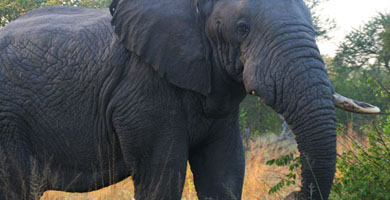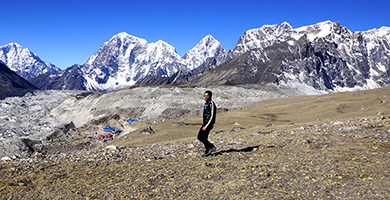Tracking Tigers in NEPAL'S Royal Bardia National Park
Author Suzan Crane explores a pristine corner of Nepal in search of the elusive Royal Bengal tiger.
It’s been several hours and we remain camouflaged under a thick forest canopy on the banks of the Karnali river in western Nepal’s remote Royal Bardia National Park. But for the melodious chatter of the area’s prolific birdlife of nearly 500 species, we’re enveloped by a symphony of silence, a natural sanctuary so absolute that I keep nodding off as we lie in wait for an elusive Royal Bengal tiger to appear. Only 50 of these endangered apex predators remain in this park, 198 total in Nepal. Despite the insistence of our guide Ram Din Mahato – a man with encyclopedic knowledge of the area — that a tiger does indeed lurk within the dense woods across the waterway, my hope of spotting one is waning. As chief naturalist for Tiger Tops’ venerable Karnali Lodge, however, this veteran tracker “reads” the forest like most of us peruse a newspaper (digital or otherwise) and does not waver in his conviction.
Ringed by traditional Tharu villages and framed by the Churia Mountains (also known as the Sivalik Hills) from behind which peek the snow-capped Himalayas, Bardia is the largest and most undisturbed protected area in the subtropical Terai region. The 968-square kilometer (374 square miles) swathe of pristine jungle and grasslands is home to 55 mammals which share their turf with rare freshwater Ganges dolphins, the Marsh Mugger and critically threatened Gharial crocodiles. The region is also home to a slithering cadre of pythons and king cobras.
Tiger Sighting: Seeing is Believing
“Just wait” he implores this anxious visitor for about the hundredth time. And so I wait, until I can sit idle no longer. Defying Ram Din’s instructions, I walk to the rim of the viewpoint in hopes of counteracting my impending stupor. And within seconds, just meters from my sightline, a stately Royal Bengal tiger gracefully skulks from the bowels of the bush to leisurely cross the narrow river. In shock and awe, I study the big cat’s fluid movements and suddenly realize how lucky I am to be among the roughly 50 percent of the park’s visitors who actually get to witness the phenomenon. And the damnedest thing of all was that none of my crew was around to see it. Our driver Ram Sing was perched in a tree providing lookout, my friend was snoozing on a blanket and Ram Din had inopportunely taken a bathroom break. So there I stood, alone in this marvel… until the others rushed over to catch the tail end of this breathtaking tale. Although it would be my first and last tiger sighting during a three day visit to this habitat of wild Asian elephants, sloth bears, and hordes of deer and monkeys, we were equally fortunate the following day to discover two of Bardia’s 24 imperiled prehistoric one-horned rhinos bathing in a watering hole some seven kilometers deeper into the park.
Safaris in Nepal
A safari in Nepal is quite unlike those I’ve experienced in Africa where pervasive wildlife carpets the plains and active visual pursuit is the name of the game. Here, patience and providence dictate the outcome of a successful sighting and once I got the hang of it, we were gifted with some incredible experiences. But animal viewing is just a footnote, in my opinion, to Bardia’s true calling. A place of remarkable beauty and meditative tranquility less than an hour’s flight (and subsequent two hour drive) from the grimy chaos of Kathmandu, Bardia is a barely commercialized enclave where authentic rural life is played out by locals oblivious to the presence of tourists. This is where customary Tharu dung thatched houses merge with basic concrete dwellings of transplanted “hillers,” and cattle, sheep and goats languidly graze amid rambling wheat, rice, and lentil fields as water buffalo haul ancient wooden carts along pocked dirt paths. Villagers wave and return our greetings of “Namaste” as we lumber across “buffer zones” skirting the park atop several of Karnali Lodge’s ten (soon to be eleven as one female is pregnant) well tended Asian elephants. We giggle like schoolchildren as we novice foreigners bathe with the fantastical beasts in the Ganges River’s largest tributary.
While Bardia is an unsullied jewel in Nepal’s minefield of political inefficiency, Karnali Lodge exists as a gleaming gem in the country’s eco-tourism crown. One of several properties and tour operations owned by Tiger Tops, Nepal’s pioneering conservation and adventure activity outfit founded 50 years ago by two British expats, the lodge is situated on 14 acres of unspoiled terrain bordering the park. In addition to allocated space for the aforementioned elephants, the site houses an organic farm that provides for the extraordinary meals we were served, and sprawling elephant polo grounds on which annual international polo championships are held. The hotel itself is further testament to the company’s sustainable ethos.
Erected by local craftsmen using indigenous materials, it utilizes solar power, energy-efficient toilets and showers and provides ecologically balanced service to the highest degree feasible to maintain its luxury-within-reason standards. The twelve original and nine newer Signature rooms are designed in muted tones that fuse with nature yet manage to exude a comfortable elegance belied by their simplicity. In addition to the requisite jeep, elephant, river, and walking safaris, Karnali offers bird-watching jaunts, educational films, and opportunities to interact with villagers, many of whom are employed by the lodge. Further, Karnali shares its bounty with its neighbors, donating up to half of their crops while providing training in the advantages of organic farming and forging partnerships for social and economic empowerment.
Tiger Tops continues to build on a legacy of responsible high end tourism that dates back to the opening of its first lodge in Chitwan National Park. Over the years the company has introduced intrepid travelers to the joys of trekking Himalayan trails, safaris through Nepal’s fertile forests, and rafting and kayaking down some of the world’s most challenging rivers – its commitment to preserving tribal cultures and protecting Nepal’s fecund resources never compromised. If you’re going to do it, do it right. To paraphrase what I’ve heard in many languages throughout my travels: “Take nothing but memories, leave nothing but footprints.”
Latest posts by Suzan Crane
- Tracking Tigers in NEPAL'S Royal Bardia National Park - June 4, 2014
- BALI by the Book: 10th Annual Ubud Writer's Festival - April 4, 2014
- Finding Serenity On The Shores Of LAKE MALAWI, Africa - February 7, 2014







